FDA Grants Breakthrough Therapy Designation to Avacincaptad Pegol for GA Treatment
The novel investigational complement C5 inhibitor is the only product for treatment of geographic atrophy to achieve two positive phase 3 pivotal trials with statistical significance.
US Food and Drug Administration (FDA)

The US Food and Drug Administration (FDA) has granted Breakthrough Therapy designation for avacincaptad pegol (Zimura®) for the treatment of geographic atrophy (GA) secondary to age-related macular degeneration (AMD).
The novel investigational complement C5 inhibitor from Iveric Bio is the first and only investigational therapy to receive Breakthrough Therapy designation for this indication. The designation was based on the 12-month pre-specified primary endpoint data in the GATHER1 and GATHER2 clinical trials.
“We believe this Breakthrough designation reflects the fact that both GATHER1 and GATHER2 met their primary endpoint with a safety profile that meets the stringent criteria required,” said Glenn P. Sblendorio, Chief Executive Officer, Iveric Bio in the release. “We are now focused on the execution of our full New Drug Application (NDA) submission and launch preparation, with the possibility of being first to market. We look forward to working collaboratively with the FDA to expedite the review timeline for avacincaptad pegol and to potentially bringing a new therapy to AMD patients impacted by GA.”
The company recently announced the submission of the first part of its NDA for rolling review, including the full clinical data package from the GATHER1 and GATHER2 clinical trials. They noted in the release to be on track to complete the final part of the NDA submission by the end of 2022.
Breakthrough Therapy designation is granted to accelerate the development and regulatory review of new medicines intended to treat a serious condition and address a significant unmet need. The medicine is required to show preliminary clinical evidence of substantial improvement in effectiveness or safety over available therapies on a clinically significant endpoint.
The decision to grant Breakthrough Therapy designation to avacincaptad pegol was based on the 12-month primary efficacy endpoint data from the pivotal trials, which evaluated the safety and efficacy of the agent in patients with GA located inside and/or outside of the clinical fovea.
The release noted the FDA required the mean rate of growth (slope) in GA area from baseline to month 12, per the special protocol agreement for the GATHER2 trial. The findings reported a significant treatment difference of 35% (P = .0050) in GATHER1 and 18% (P = .0039) in GATHER2, compared to sham using observed (non-transformed) data.
Then, using square root transformation, the data show a significant treatment difference of 28% (P = .0063) in GATHER1 and 14% (P = .0064) in GATHER2 using square root transformation. Both GATHER1 and GATHER2 observed no events of serious intraocular inflammation, vasculitis, or endophthalmitis.
“In both GATHER1 and GATHER2, avacincaptad pegol consistently showed a treatment effect with the first measurement at month 6 that was persistent and continued to increase over time, with observed efficacy rates of up to 35%,” said Pravin U. Dugel, MD, President, Iveric Bio. “We believe avacincaptad pegol has the potential to safely and effectively preserve central vision by saving photoreceptor cells for patients living with this life-changing disease that leads to irreversible blindness.”
In a recent interview with HCPLive, David Lally, MD, an ophthalmologist and investigator with New England Retina Consultants, provided insight into the historic burden patients with GA face and the promise of an agent to treat the debilitating disease.
“It’s like losing film…in your camera,” Lally said. “Patients develop severe loss of their central vision over time, and this is a huge unmet need, that as we know when geographic atrophy begins to develop, we currently have no FDA-approved treatments for impacting the disease.”
He described the pivotal efficacy and safety findings from the GATHER1 and GATHER2 trials and how avacincaptad pegol may serve as a major shift within a physician’s toolbelt.
“This is the first time ever that we have had 2 pivotal studies of which both show statistical significance in the effect of the therapy at reducing lesion size,” Lally said. “We’re excited and thrilled to have hopefully our first tool in the belt to impact this disease.”